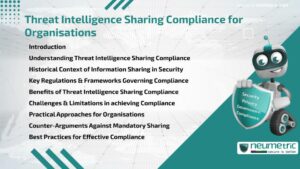Table of Contents
ToggleIntroduction
Threat Intelligence sharing Compliance has become a crucial component of modern Cybersecurity. Organisations are under increasing pressure to exchange Cyber Threat data responsibly, both to protect themselves & to strengthen collective defense across industries. Compliance involves adhering to laws, standards & frameworks that regulate how Threat information is collected, stored & shared. This article explains the concept, traces its history, highlights benefits & limitations & provides practical guidance on implementing Threat Intelligence sharing Compliance in an organisation.
Understanding Threat Intelligence Sharing Compliance
Threat Intelligence sharing Compliance refers to the structured process of meeting legal, regulatory & industry requirements for exchanging information on potential Cyber Threats. It ensures that sensitive details are shared securely, without breaching Privacy, Intellectual Property rights or Confidentiality Agreements.
At its core, this Compliance Framework is about balance-organisations must protect Sensitive Data while still contributing to a broader pool of intelligence that helps mitigate Risks across sectors.
Historical Context of Information Sharing in Security
The idea of sharing security-related information is not new. In the early days of the Internet, organisations & Government agencies exchanged Threat details informally through mailing lists & forums. Over time, the growth of sophisticated attacks highlighted the need for more formal & regulated information sharing.
Initiatives such as the establishment of Information Sharing & Analysis Centers [ISACs] in the late 1990s provided a structured approach for industries like Finance, Energy & Healthcare. These efforts laid the foundation for today’s Threat Intelligence sharing Compliance Requirements.
Key Regulations & Frameworks Governing Compliance
Several Global Standards & legal frameworks influence how organisations approach Compliance:
- General Data Protection Regulation [GDPR] in the European Union regulates the handling of Personal Data, impacting how Cyber Threat indicators are exchanged.
- Cybersecurity Information Sharing Act [CISA] in the United States encourages sharing of Threat information between Government & Private Entities.
- ISO/IEC 27010 Standard focuses on Inter-Sector & Inter-Organisational communications related to Information Security.
- NIS Directive in the European Union obliges Operators of Essential Services to report incidents & share Threat Intelligence.
These frameworks collectively shape how organisations achieve Threat Intelligence sharing Compliance across jurisdictions.
Benefits of Threat Intelligence Sharing Compliance
Organisations that adopt compliant sharing practices can experience significant benefits:
- Enhanced Security Posture through access to timely & relevant Threat data.
- Reduced Duplication of Effort as peers collaborate on identifying & mitigating Risks.
- Regulatory Assurance by demonstrating adherence to required laws & standards.
- Trust Building with Partners, Customers & Regulators through transparent practices.
By pooling intelligence, organisations act like members of a Neighborhood Watch-working together to spot & stop suspicious activity.
Challenges & Limitations in achieving Compliance
Despite its benefits, Threat Intelligence sharing Compliance presents challenges:
- Legal Uncertainties across international borders can complicate data exchange.
- Operational Costs for deploying secure sharing platforms & training staff.
- Risk of Oversharing where sensitive business data may be disclosed unintentionally.
- Trust Barriers as competitors may hesitate to share information.
These limitations highlight why Compliance requires careful planning & continuous oversight.
Practical Approaches for Organisations
To achieve Compliance effectively, organisations can adopt the following strategies:
- Implement Clear Policies outlining what data can & cannot be shared.
- Adopt Trusted Platforms such as ISACs or Government-Sponsored Programs for secure exchange.
- Conduct Regular Training so staff understand Compliance obligations.
- Use Anonymisation & Encryption to safeguard sensitive elements of shared data.
These steps help create a structured yet flexible approach to Threat Intelligence sharing Compliance.
Counter-Arguments Against Mandatory Sharing
Some experts argue against mandatory information sharing, raising concerns such as:
- Risk of Misuse where shared intelligence could be exploited by adversaries.
- Compliance Fatigue where organisations feel overwhelmed by overlapping regulatory requirements.
- Potential Exposure of Trade Secrets that could undermine competitiveness.
These counterpoints remind us that Compliance should balance collective security with individual organisational interests.
Best Practices for Effective Compliance
Organisations aiming for success in Threat Intelligence sharing Compliance should:
- Align with Recognised Frameworks like ISO/IEC 27010.
- Build Strong Governance Structures to oversee Compliance efforts.
- Foster a Culture of Collaboration where sharing is seen as beneficial rather than burdensome.
- Regularly Review Legal Updates to ensure continued Compliance across jurisdictions.
By embedding these Best Practices, organisations can strengthen both their Compliance posture & their contribution to collective Cybersecurity.
Takeaways
- Threat Intelligence sharing Compliance is about balancing security, Privacy & regulatory requirements.
- Historical efforts like ISACs laid the groundwork for today’s frameworks.
- Compliance brings benefits such as enhanced Security & Regulatory assurance but also faces limitations like Legal complexities & Trust issues.
- Practical steps & Best Practices enable organisations to navigate Compliance effectively.
FAQ
What is Threat Intelligence sharing Compliance?
It is the process of meeting legal & regulatory requirements when exchanging information about Cyber Threats with other organisations or authorities.
Which laws or standards govern Threat Intelligence sharing Compliance?
Key frameworks include GDPR, CISA, ISO/IEC 27010 & the EU NIS Directive.
What are the Risks of sharing too much intelligence?
Oversharing may expose sensitive business data, Intellectual Property or Customer Information to unintended parties.
How can organisations ensure Compliance when sharing data internationally?
They can use anonymisation, encryption & adopt frameworks that address cross-border data sharing issues.
What are common barriers to Compliance?
Barriers include legal uncertainties, high operational costs, Risk of misuse & lack of trust between organisations.
Do all organisations need to follow Threat Intelligence sharing Compliance?
While critical sectors may be legally required, all organisations benefit from aligning with Compliance frameworks to reduce cyber Risks.
Need help for Security, Privacy, Governance & VAPT?
Neumetric provides organisations the necessary help to achieve their Cybersecurity, Compliance, Governance, Privacy, Certifications & Pentesting needs.
Organisations & Businesses, specifically those which provide SaaS & AI Solutions in the Fintech, BFSI & other regulated sectors, usually need a Cybersecurity Partner for meeting & maintaining the ongoing Security & Privacy needs & requirements of their Enterprise Clients & Privacy conscious Customers.
SOC 2, ISO 27001, ISO 42001, NIST, HIPAA, HECVAT, EU GDPR are some of the Frameworks that are served by Fusion – a SaaS, multimodular, multitenant, centralised, automated, Cybersecurity & Compliance Management system.
Neumetric also provides Expert Services for technical security which covers VAPT for Web Applications, APIs, iOS & Android Mobile Apps, Security Testing for AWS & other Cloud Environments & Cloud Infrastructure & other similar scopes.
Reach out to us by Email or filling out the Contact Form…





